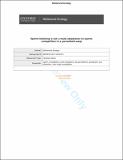Files in this item
Sperm blocking is not a male adaptation to sperm competition in a parasitoid wasp
Item metadata
| dc.contributor.author | Boulton, Rebecca A | |
| dc.contributor.author | Cook, Nicola | |
| dc.contributor.author | Green, Jade | |
| dc.contributor.author | Greenway, Elisabeth Virginia | |
| dc.contributor.author | Shuker, David Michael | |
| dc.date.accessioned | 2018-12-10T09:37:18Z | |
| dc.date.available | 2018-12-10T09:37:18Z | |
| dc.date.issued | 2018-01-13 | |
| dc.identifier | 251399787 | |
| dc.identifier | f49d51e6-6a6e-4d7c-a54d-12ddc2f7ade8 | |
| dc.identifier | 85040809544 | |
| dc.identifier | 000422957500035 | |
| dc.identifier.citation | Boulton , R A , Cook , N , Green , J , Greenway , E V & Shuker , D M 2018 , ' Sperm blocking is not a male adaptation to sperm competition in a parasitoid wasp ' , Behavioral Ecology , vol. 29 , no. 1 , pp. 253-263 . https://doi.org/10.1093/beheco/arx156 | en |
| dc.identifier.issn | 1045-2249 | |
| dc.identifier.other | ORCID: /0000-0003-4462-0116/work/60427604 | |
| dc.identifier.uri | https://hdl.handle.net/10023/16648 | |
| dc.description | This work was supported by a NERC Doctoral Training Grant studentship to RAB. Data archived in Dryad Digital Repository at doi:10.5061/dryad.t0877 | en |
| dc.description.abstract | The extent to which sperm or ejaculate-derived products from different males interact during sperm competition—from kamikaze sperm to sperm incapacitation—remains controversial. Repeated matings in the parasitoid wasp Nasonia vitripennis lead to a short-term reduction of efficient sperm use by females, which is crucial for a haplodiploid organism when needing to allocate sex adaptively (i.e. by fertilizing eggs to produce daughters). Repeated matings by females in this species, therefore, constrain sex allocation through this “sperm-blocking” effect, eliciting a cost to polyandry. Here, we explore the causes and consequences of sperm blocking and test the hypothesis that it is an ejaculate-related trait associated with sperm competition. First, we show that sperm blocking, which leads to an overproduction of sons, is not correlated with success in either offensive or defensive roles in sperm competition. Then, we show that the extent of sperm blocking is not affected by self–self or kin–kin ejaculate interactions when compared to self vs nonself or kin versus nonkin sperm competition. Our results suggest that sperm blocking is not a sperm competition adaptation, but is instead associated with the mechanics of processing sperm in this species, which are likely shaped by selection on female reproductive morphology for adaptive sex allocation. | |
| dc.format.extent | 1323344 | |
| dc.language.iso | eng | |
| dc.relation.ispartof | Behavioral Ecology | en |
| dc.subject | Sperm competition | en |
| dc.subject | Post-copulatory sexual selection | en |
| dc.subject | Polyandry | en |
| dc.subject | Sex allocation | en |
| dc.subject | Local mate competition | en |
| dc.subject | QH301 Biology | en |
| dc.subject | DAS | en |
| dc.subject.lcc | QH301 | en |
| dc.title | Sperm blocking is not a male adaptation to sperm competition in a parasitoid wasp | en |
| dc.type | Journal article | en |
| dc.contributor.institution | University of St Andrews. School of Biology | en |
| dc.contributor.institution | University of St Andrews. Centre for Biological Diversity | en |
| dc.contributor.institution | University of St Andrews. Scottish Oceans Institute | en |
| dc.contributor.institution | University of St Andrews. Institute of Behavioural and Neural Sciences | en |
| dc.identifier.doi | https://doi.org/10.1093/beheco/arx156 | |
| dc.description.status | Peer reviewed | en |
| dc.date.embargoedUntil | 2018-12-08 |
This item appears in the following Collection(s)
Items in the St Andrews Research Repository are protected by copyright, with all rights reserved, unless otherwise indicated.

